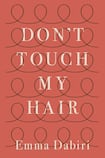
I am a mulatto, that is to say I have one white parent. I am half black. My son is a quadroon, one quarter black. My daughter is an octoroon, one eighth. Had we all been born into slavery, this is how we would have been described. It was common for slave owners to rape their female slaves, to “breed” them as it was called and thus expand their livestock. Slaves of mixed blood, particularly women were more likely to escape punishing field work and be given a job in the master’s house where he would have easier and constant access to these fair-skinned or “high yellow” women with their long, black silky hair. What was the master’s wife to do?
In her excellent and far reaching book, Emma Dabiri takes us on a journey around slavery, cultural appropriation, science, mathematics and decolonisation and all via hair.
If you are black, to say that hair is a political issue is an understatement. Whether your hair is short, curly, kinky, dyed, straightened, supplemented with a weave, oiled, long, wavy, brown, black, cane-rowed, afro or dreadlocked speaks volumes to another black person and as Dabiri’s book demonstrates, also determines how a white person sees and responds to you. In 1905 a German scientist invented the “hair guage” to determine the whiteness of people of mixed blood. Depending on the score, mixed race children were forcibly sterilized to prevent the contamination of the white race “by Negro blood on the Rhine in the heart of Europe”.
Don’t Touch My Hair is a lament and a call to arms. In discussing the evils and savagery of the European rape of Africa, Dabiri says “the most destructive consequence of colonialism was not the control of the land but the control of the minds of the people”. Thus the Eurocentric standards of beauty, acceptability and femininity infected black consciousness resulting in the desire for straight hair using dangerous chemical compounds or red hot straightening irons, in carcinogenic skin bleaching creams and the rampant colourism in black communities where the paler the skin, the higher up the food chain you go. In New Orleans for example, the black cultural elite used the brown paper bag test to allow guests into their parties. A brown paper bag was attached to the door. If you are darker than the bag, you can’t come in.
Analysis of power
What is lost in all this is an appreciation for the essence of black African culture and hairstyles that, as Dabiri outlines in a fascinating chapter on fractals, binary coding and mapping, borrow from indigenous African mathematical prowess. This “doesn’t fit the narrative of black primitivism” she tells us.
But there is another type of borrowing taking place, and in her discussion of cultural appropriation by Kim Kardashian, Justin Beiber and Madonna, Dabiri unpicks what many black people find so disturbing about the European desire to strip black people of their cultural goods. “The key to understanding what is and isn’t appropriation requires an analysis of power.” The powerful group “systematically extracts the cultural resources of a subordinate group, erasing the subordinate group’s involvement in the process”.
“There is no other group of people on Earth whose cultural production has the mass appeal of black culture yet is simultaneously derided and effectively repackaged and claimed by everybody else.” And “sometimes it can feel as though black people are not allowed to keep anything (except seasoned food)”.
There are personal, intimate moments in this exploration of black history, culture and hair such as stories of Emma’s childhood in inner city Dublin. On one occasion, a nun’s “watery eyes refocused then blazed upon seeing me. ‘I spent years in Nigeria,’ she thundered before proceeding to pull my lips back because ‘your people have such beautiful teeth!’” Or her mistaken assumption that at SOAS, the University of London School of African and Asian studies, there might be something of a black cultural life. Instead she encountered “the tea-drinking, poi-swinging, drum-playing, often dreadlocked” white hippy cohort with their “palpable privilege” and gap-year expertise on Africa and India.
There is so much in this book I recognised. “Until the late 1990s, being black and Irish in Ireland was to have almost unicorn status. Except everybody loves unicorns.”
Female entrepreneurship
In the days of slavery, white mistresses would routinely shave the hair of the female house-slaves both to render them less attractive to their husbands and because black women with visible white ancestry were considered a threat to the social order. Even today, there are still questions asked about the mixed-race woman, still explanations to be made. I echo what Dabiri says on identity. “In different contexts I’ve been told I’m too black. I’m too white. I’m too stuck-up. I’m too light-skinned, I think I’m too nice. I’m too posh. I’m too street. I’m too Irish, blah, blah, fuckin blah.”
I’m hoping for another book from Dabiri with a longer chapter on men’s hair and more memoir. I’m glad there was so much hope in this book on an otherwise bleak subject but Dabiri found much to celebrate from female entrepreneurship to black natural hair movements and black self-empowerment. Hugh Trevor Roper writes “perhaps in the future, there will be some African history to teach. But at present there is none, or very little; there is only the history of the Europeans in Africa. The rest is largely darkness, like the history of pre-European, pre-Columbian America. And darkness is not a subject for history.” Emma Dabiri’s book provides a satisfying riposte.
'It is difficult for words to hurt me now': Emma Dabiri is interviewed by Shilpa Ganatra in Life & Style

